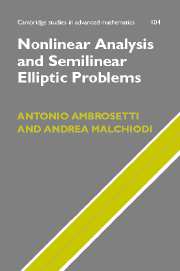4 - Topological degree, II: global properties
from Part I - Topological methods
Published online by Cambridge University Press: 19 May 2010
Summary
In this chapter we will exploit the global properties of the Leray–Schauder topological degree to discuss the nonlocal structure of the solutions set of several classes of elliptic equations and to prove the Rabinowitz global bifurcation theorem.
As recalled before, another important bifurcation result dealing with the case of variational operators will be discussed in Section 12.3.
Improving the homotopy invariance
The main purpose of this section is to prove a more general version of the homotopy invariance property (P.5). This will be useful in several applications later on.
Let X be a Banach space, U ⊂ [a, b] × X be open and bounded. We set Uλ = {x ∈ X : (λ, x) ∈ U}, whose boundary is denoted by ∂Uλ.
Let us remark that one has to distinguish ∂Uλ from (∂U)λ: in general, one has that ∂Uλ ⊂ (∂U)λ, see Figure ??.
Consider a map h(λ, x) = x − k(λ, x) such that k(λ, ·) is compact and 0 ∈ h(∂U). Such a map h will also be called an admissible homotopy on U. If h is an admissible homotopy, for every λ ∈ [a, b] and every x ∈ ∂Uλ, one has that hλ(x) := h(λ, x) ≠ 0 and it makes sense to evaluate deg(hλ, Uλ, 0).
Theorem 4.1If h is an admissible homotopy on U ⊂ [a, b] × X, then deg (hλ, Uλ, 0) is constant for all λ ∈ [a, b].
- Type
- Chapter
- Information
- Nonlinear Analysis and Semilinear Elliptic Problems , pp. 55 - 74Publisher: Cambridge University PressPrint publication year: 2007

